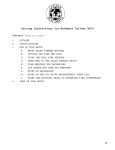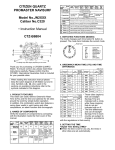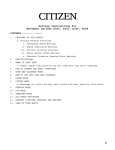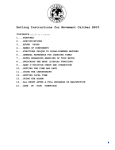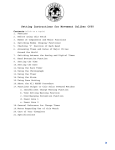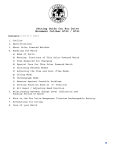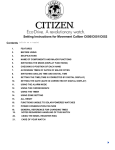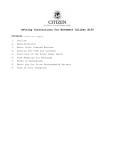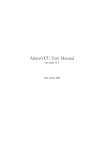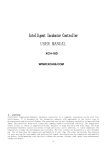Download Citizen Eco-Drive BM0310-54L Specifications
Transcript
SETTING INSTRUCTIONS FOR PERPETUAL CALENDAR MOVEMENT CALIBER E760, E761, E76x Contents (click on a topic) 1. FEATURES 2. BEFORE USING 3. SPECIFICATIONS 4. SETTING THE TIME AND DATE 5. FUNCTIONS UNIQUE TO SOLAR-POWERED WATCHES 6. GENERAL REFERENCE FOR CHARGING TIMES 7. NOTES REGARDING USE OF THIS WATCHES 8. ABOUT THE ECO DRIVE RECHARGEABLE BATTERY 9. ALL-RESET 10. REFERENCE POSITION ALIGNMENT 11. CARE OF YOUR TIMEPIECE Return to Table of Contents 1. FEATURES This watch is a solar-powered watch that contains a solar cell in its face that drives the watch by converting light energy into electrical energy. It is equipped with numerous functions including a perpetual calendar that changes the year, month and day automatically through February 28, 2100, including leap years, a time difference correction function that makes it possible to easily change the time difference without stopping the watch, and a power save function that reduces current consumption when the solar cell is not exposed to light. 2. BEFORE USING This watch is a solar powered watch. Be sure to fully charge it prior to use and setting This watch is a solar-powered watch. Make sure to charge the watch prior to use by adequately exposing it to light. If the watch should happen to stop as a result of being insufficiently charged, charge by exposing the watch to intense light such as direct sunlight. An Eco Drive rechargeable battery (manganese titanium) is used in this watch to store electrical energy. This Eco Drive Rechargeable battery is a clean energy battery that does not contain mercury or other toxic substances. Once fully charged, the watch circuit will continue to keep time for about 2 years without additional charging (when the power save function is operating). <Proper Use of this Watch> To use this watch comfortably, make sure to recharge it before it stops running completely. There is no risk of overcharging no matter how much the watch is charged (Overcharging Prevention Function). It is recommended that the watch be recharged everyday. Return to Table of Contents Return to Table of Contents 3. SPECIFICATIONS In the case the crown is of the screw-lock type, operate the crown after first loosening the screw and then make sure to securely retighten the screw after the crown has been operated. Movement Caliber E760 Accuracy Within +/- 15 seconds per month on average. (When o worn at normal temperatures of 5 C to 35 to 95 Operating Temperature o o o C / 41 o F F -10 C to 60 o C / 14 o F to 140 o F Display function Time Calendar Hours, minutes seconds (the second hand moves every second while the hour and minute hand move every 15 seconds.) Date Display (With rapid correction function) Month and years elapsed since the most recent leap year are displayed by the second hand (only displayed when correcting the date) • • • Additional Features • • • Eco Drive Rechargeable Power Save 1 Feature Power Save 2 Feature Time difference correction function (forward and backward in 1 hour units Insufficient recharge warning Time setting warning function Overcharging prevention feature Eco Drive Manganese Titanium Rechargeable Battery. (Not user replaceable.) Battery From a full charge to stop: Continuous operating time Approximately 5 years (while in operation of power save 2 feature) 2 Second interval low charge warning to stop: Approximately 2 Days • Note: specifications subject to change without notice. Return to Table of Contents Return to Table of Contents 4. SETTING THE TIME AND DATE If the watch is provided with a cove open, the cover to set the time and date, and close the cover once the time or date has been set. (0) Normal position (hours and day/correction if time difference (1) Date correction position (correction of number of years elapsed since the most recent leap year and month (2) Time setting position (correction of seconds and minutes Seconds (displays number of years elapsed since the most recent leap year and month during date correction Setting the Time 1. When the crown is pulled out to the second click (time setting position), the second hand rapicly advances to the 0 seconds position and stops. 2. Turn the crown and set the time. When the crown is turned to the right, the hour and minute hands move forward (clockwise rotation). 1. When turned to the left, the hour and minute hands move backward by one minute (counter-clockwise rotation). • When the crown is turned continuously, the hands advance rapidly. Turn the crown to either the left or right to stop the hands from advancing rapidly. NOTE 1: When correction in the forward direction, the date changes when the hour and minutes hands indicate 12:00 AM. However, when the date is changed 7when the hands are in the “rapid advance” mode, the hour and minute hands “pause” at the 12:00 am and then resume rapid advancement. NOTE 2: When correcting in the backward direction, the date does not change even if the hour and minute hands pass 12:00 AM 3. Return the crown to the normal position in synchronization with a telephone time signal or other time service. Return to Table of Contents Return to Table of Contents Setting the Date This watch is provided with a perpetual calendar function. Once it is set, the year, month and date change automatically, including leap years. <How to Read Month and Year How to read the month: January: Between 1:00 and 2:00 February: Between 2:00 and 3:00 : : December: Between 12:00 and 1:00 How to read the year: Leap year: First mark in each month zone 1 year after most recent leap year: Second mark in each month zone 2 years after the most recent leap year: Third mark in each month zone 3 years after the most recent leap year: Fourth mark in each month zone <Quick Reference Table for Number of Years Since Most Recent Leap Year> 1. When the crown is pulled out to the first click (calendar correction position), the second hand moves to the year and month position stored in memory and then stops 2. Turn the crown and set the date a. Turn the crown to the right to set the second hand to the position corresponding to the year (number of years elapsed since the most recent leap year) and month. Turning the crown continuously causes the second hand to advance rapidly. Examples ! In the case of December in a leap year: Align the second hand at ‘0’ seconds. ! In the case of April in a year that is three years after the most recent leap year: Align the second had as 23 seconds (between 4:00 and 5:00) B. The date is advanced by one day if the crown is turned to the left. Turning the crown continuously causes the date to be advanced continuously. Turn the crown to either the left or right to stop the date from rapidly advancing. 3. Always make sure to return the crown to the normal position next to the case after setting the date. The second hand advances to the current second and the hands begin to move normally. Return to Table of Contents Return to Table of Contents <When Setting the Date by Continuously Turning the Crown> The date can be set easily by stopping advancing the date rapidly two to three days before the correct date and then advancing the date one day at a time. <When the Date has been set to a date that does not exist> The date automatically changes to the first day of the following month when the crown is returned to the normal position from the date correction state. Examples: Normal Years: • March 1 when the date has been set to February 29.30 or 31 October 1 when the date has been set to September 31 Leap Years • March 1 when the date has been set to February 30 or 31 October 1 when the date has been set to September 31 Correcting the Time Difference When button (A) is pressed and the crown is turned continuously, time difference can be corrected in 1 hour increments. Time difference cannot be corrected continuously. The time difference can be corrected for 30 seconds after button (A) has been pressed or for 30 seconds after time difference correction (after the hands finish moving) 1. Put the crown in the normal position. 2. When button A is pressed, the second hand performs a demonstration movement (forward rotation -> backward rotation -> forward rotation). 3. Correct the time difference by turning the crown to the right or left. 1. When the crown is turned to the right, the hour hand moves forward by one hour (clockwise rotation). 2. When the crown is turned to the left, the hour hand moves backward (counterclockwise-rotation) by one hour. Note 1: If the time difference is corrected in the forward direction, the date after the hands are finished moving is corrected by +1 day when the hour and minute hands pass 12:00 AM. Pay attention to AM and PM when correcting the time difference. Note 2: When returning the time difference to its original setting, return the hour hand in the opposite direction in which it was corrected. If the time difference is corrected in the backward direction, the date after the hands are finished moving is corrected by –1 day when the hour and minute hands pass 12:00 AM. This takes about two minutes, however, since the date is corrected in the forward direction. Return to Table of Contents Return to Table of Contents Example: Setting the time difference of London (local time) when the time in Tokyo (home time) is 10:OO AM: The time difference between Tokyo and London is -9 hours. Since it is 1:00 AM in London when it is 10:00 AM in Tokyo, in the case of correcting the time difference at this time: 1. Press button A. 2. Turn the crown to the left to turn the hands backward (counter-clockwise) by 9 hours. Note: If the crown is turned to the right to move the hands clockwise to set the time to 1:00, the time will be 1:OOPM and the calendar function will not operate correctly, preventing the date from changing at the proper time. Case of Correcting Time Difference by -9 Hours <Proper Correction Procedure> Direction of time difference correction <Improper Correction Procedure> Direction of improper time difference correction Direction of returning time difference correction The time difference cannot be corrected when the second hand is moving at twosecond intervals indicating that the watch is insufficiently charged. Correct the time difference after charging the watch by exposing it to light so that the second hand returns to one- second interval movement. Reference: Time Differences of Major World Cities Based on UTC • • Cities (regions) in which daylight savings time is used are indicated with a 0, while those in which it is not are indicated with an X. The time difference and use of daylight savings time of each city are subject to change by the particular country. Return to Table of Contents Return to Table of Contents 5. FUNCTIONS UNIQUE TO SOLAR-POWERED WATCHES When the watch becomes insufficiently charged, the following warning functions are activated to inform the wearer that the watch is insufficiently charged. Note 1 Irregular two-second-interval movement will continue if the time is not reset Note 2 Check the date since it also may not be correct Return to Table of Contents Return to Table of Contents Insufficient Charging Warning Function The second hand moves at two-second intervals to indicate that the watch is insufficiently charged. Although the watch will continue to operate normally at this time as well, it will stop after about 2 days have elapsed since the start of twosecond-interval movement. Expose the watch to light to return the second hand to onesecond interval movement. Time Setting Warning Function When the watch is again exposed to light after stopping, although the second hand begins to move, since the time is incorrect, the second hand moves irregularly at twosecond intervals to indicate that the time is incorrect. Reset the time after the watch has been sufficiently charged. The second hand will continue to move irregularly at two-second intervals unless the time is reset. Overcharging Prevention Function The overcharging prevention function is activated when the Eco Drive Rechargeable battery is fully charged so that it is not charged further. Power Save 1 When power is no longer generated as a result of light not shining on the solar cell continuously the second hand stops and the watch enters Power Save 1 to reduce power consumption of the rechargeable battery. The minute and hour hands continue to keep time even though the second hand is stopped. Furthermore, operation of the calendar is linked with the movement of the hour and minute hands <Power Save 2> When the Power Save 1 state continues for about 3 days, the watch automatically switches to the Power Save 2 state and movement of the hour and minute hands as well as the calendar operation stop to further reduce power consumption of the rechargeable battery. Note: The power save function is not activated even when power is not generated as a result of light not shining on the solar cell during the time the Eco Drive Rechargeable battery is fully charged and the overcharging prevention function is activated. Canceling Power Save The power save function is canceled when the solar cell is exposed to light and power generation is resumed. The of the hands advance rapidly to the current time and begin moving. Return to Table of Contents Return to Table of Contents 6. GENERAL REFERENCE FOR CHARGING TIMES The time required for recharging varies according to the model of the watch (color of the dial, etc.). The following times are shown below to serve only as a reference. Recharging time refers to the amount of time the watch is continuously exposed to light. Running Time At Full Charge Low Charge Warning Quick Start Feature 5 Years 2 Days No Charge Rates from Indoor Light Source Indoors, Office (500 lux) One Day Use 2 Hours One Second Step 27 Hours Full Charge 22Days Charge Rates from Outdoor Light Source Outdoors Cloudy (10,000 lux) One Day One Second Full Use Step Charge 6 Minutes 2 hours 26 Hours Fluorescent at 6" Distance Incandescent at 20" Distance (3000 lux) One Day One Second Full Use Step Charge 19 Minutes 10 Hours 82 hours Outdoors Bright Sun (100,000 lux) One Day One Second Use Step 1.5 Minutes 1 Hour Full Charge 7 Hours 7.NOTES REGARDING USE OF THIS WATCH <Try to keep the watch charged at all times. > Please note that if you frequently wear long sleeves, the watch can easily become insufficiently charged as a result of it being concealed and unable to be exposed to light. When you take the watch off, try to place it in as bright a location as possible to ensure that it always keeps the correct time. CAUTION - Charging Precautions Avoid recharging at high temperatures (over about 60'C/140'F) since this may result in dam- age to the watch during recharging. Examples: • Charging the watch in close proximity to an incandescent lamp, halogen lamp or other light source that can easily reach high temperatures. • Charging the watch in a location that reaches high temperatures such as on a car dashboard. • When charging the watch with an incandescent lamp, always make sure the watch is at least 50 cm (20 in.) away from the lamp so that it does not reach excessively high temperatures during charging. 8. REPLACING THE ECO DRIVE RECHARGEABLE BATTERY The rechargeable battery used in this watch does not have to be periodically replaced in the manner of ordinary batteries as it can be charged and discharged repeatedly. Note: This rechargeable battery is not a user replaceable item Return to Table of Contents Return to Table of Contents 9. ALL-RESET The display of this watch may not read correctly as a result of being subjected to the effects of static electricity or strong impact and so forth. When this happens, perform the procedure described in section "10. REFERENCE POSITION ALIGNMENT" after performing the all-reset procedure described below. 1. Pull out the crown to the second click (time setting position). • The second hand moves to the 0-position stored in memory and stops. 2. Continuously press button (A) for at least 1 second. • The hour and minute hands perform a demonstration movement (forward movement backward movement ---> forward movement). • The second hand makes one complete revolution in the clockwise direction • This completes the all-reset procedure. Always make sure to perform the reference position alignment procedure after performing all-reset. Note 1: Demonstration movement is not performed when the watch is insufficiently charged. Perform the all-reset procedure only after charging the watch sufficiently. Note 2: Do not perform the all reset procedure while the date is changing. This can cause the date position to shift. If the date position should happen to become out of position, pull out the crown to the first click after completing the all-reset procedure and the crown to the left while pressing button (A) to set the date to the correct position. 10. REFERENCE POSITION ALIGNMENT After performing the all-reset procedure, align the hour and minute hands at their reference positions by pulling out the crown to the second click, and the second hand and date to their reference positions by pulling out the crown to the first click. 1. Align the Hour and minute hands at the 12:00 position with the crown pulled out to the second click. • Turning the crown to the right moves the Hour and minute hands forward. • Turning the crown to the left moves the Hour and minute hands backward. • Turning the crown continuously causes the hands to advance rapidly. Turn the crown to the left or right to stop the hands from advancing rapidly. 2. Align the second hand at the 12:00 position with the crown pulled out to the first click. In addition, align the date at ‘1’. • Turning the crown to the right moves the second hand to move forward 1 second. • Turning the crown to the left moves the date to move one day forward. • Turning the crown continuously to the left caused the date to advance continuously. Turn the crown to the Turn the crown to the left or right to stop the hands from advancing rapidly. 3. Once each hand has been aligned at the 12:00 position and the date has been aligned to ‘1’, return the crown to the closed position next to the case. NOTE 1: It takes about 1 second for the watch to store the reference position in memory. Once the reference position has been stored in memory, the second hand will begin irregular two-second-interval movement. The reference position may not be stored in memory if the crown is operated before the start of the irregular two-second-interval movement after the returning the crown to the normal position. NOTE 2: The second hand will continue to remain stopped even if the crown is returned to the normal position unless the reference position alignment procedure is performed. 4. After performing the reference position alignment procedure, properly reset the time and date. The watch shows 12:00 AM after reference position alignment has been performed. Set the time and date by referring to section “4. SETTING THE TIME AND DATE” while paying attention to the AM and PM. Return to Table of Contents Return to Table of Contents PRECAUTIONS ABOUT CARE AND HANDLING OF WATCHES TEMPERATURE CARE Avoid temperature extremes. Exposing your watch to high temperatures, such as placing it on the dashboard of a vehicle or use in a hot tub, may cause the watch to malfunction, shorten battery life or damage certain components. Leaving the watch in extreme cold temperatures may cause irregular timekeeping until the watch returns to normal operating temperature. SHOCK-RESISTANT The watch may be worn while playing golf or other activities, but avoid severe shocks such as dropping it on a hard surface. MAGNETIC-RESISTANT No problem should occur from using the watch around ordinary household electric appliances such as TV sets or stereos. Keep away from magnets. CHEMICAL/GAS RESISTANT Do not expose the watch to chemicals or gases for long periods. WATCH CLEANING Stains, waterspots and accumulated dirt on the case, crystal or band should be removed with a soft cloth to prevent damage and premature wear. HANDLING OF WATER-RESISTANT WATCHES Although water-resistant watches are warranted, steps should be taken to avoid damage that may result from accidents or mishandling: ■ Do not operate the crown or push-button in the water or while the watch is wet. Tighten screw lock crown completely. ■ Should the watch become immersed in water, dry it off right away. If the watch comes in contact with salt water, be sure to rinse it thoroughly in warm fresh water to remove any trace of salt. ■ If a watch is wet from cleaning or by accident, never store it in a closed container. It should be dried immediately or taken to a watchmaker or jeweler if moisture is inside the case to prevent damage from rust. ■ Vital components necessary to resist the entrance of moisture deteriorate with time and use. Gaskets, crowns and other materials should be replaced every year or two to ensure Marking on the Dial Marking on the Caseback that water resistant quality remains at factory specifications. CARE FOR METAL BRACELETS To extend the life and maintain the good appearance of the metal watch bracelet, the following recommendations are given: ■ Be aware that since the watch and bracelet is worn next to the skin, it collects dust and perspiration and becomes soiled if not cleaned regularly. This is particularly true of the inner parts of the links or mesh of the bracelet. ■ Soil and rust, when present in a bracelet, are dissolved by perspiration and can cause staining of cuffs and irritation of the skin in some instances. ■ Heavy perspiration should be wiped off the watch and bracelet with a soft dry cloth. The bracelet should be cleaned occasionally by using an old toothbrush and warm soapy water after which the soap is thoroughly rinsed with clear water and the bracelet dried completely. The foregoing manner of cleaning should not be done if the watch is not water-resistant but should instead be done by your jeweler. CARE FOR STRAPS LEATHER ■ Heavy perspiration, if not removed from a leather strap, can wash out the natural oils and cause the leather to become dry and deteriorate. Any moisture should be blotted with a soft dry cloth or paper towel and the strap allowed to dry naturally. ■ Salt residue and soil can be removed from the leather by cleaning with a dampened soft cloth and mild soap or saddle soap. ■ Occasionally, the inside surface of the strap should be cleaned by using a soft cloth dampened with alcohol. ■ The strap should always be worn a little loosely (one finger space between wrist and strap) to allow air to circulate thus causing any moisture to evaporate. RUBBER ■ Rubber straps should be washed frequently with mild soap and warm water using a soft brush. ■ Thorough cleaning, using the same method, should especially be done after use in salt water. ■ Solvents, oils, perspiration, tanning lotion and salt can cause rubber to deteriorate if not removed. Water-resistant characteristics Face washing, splashes, sweat, raindrops, etc. Swimming Skin diving (diving without air tanks) Scuba diving (diving with air tanks) Non water-resistant watch and must be kept away from water. NONE NONE NO NO NO NO NONE WATER RESIST OK NO NO NO WR100M WR10bar WR150M WATER RESIST OK OK OK NO For frequent use with water. It is not specially designed for scuba diving. WR200M WATER RESIST OK OK OK OK For skin and scuba diving. Usable up to the respective indicated depths. An ordinary water-resistant watch and can withstand splashes, sweat, rain-drops and etc. for daily life use. See instruction book for further information Return to Table of Contents Return to Table of Contents Water Resistance The water-resistant quality of our timepieces is offered in varying degrees depending on the model. This ranges from non-water resistant models to those suitable for SCUBA diving. Water resistance of our timepieces is measured in BAR or Barometric Pressure. Each BAR of pressure is equal to 14.5 pounds per square inch of pressure. Water resistance is measured when the watch is at a static, or motionless state. As the watch is moved in water, such as from the motion of swimming, pressure is added from velocity. While you may be swimming in a pool at surface level, the watch may be experiencing forces equal to that of 100 feet of water pressure (3 BAR). Diving into a pool can cause forces on the watch to exceed those pressures. As such, you should always allow a margin of safety when exposing your watch to moisture. Never "push the limit" of the degree of water resistance of your timepiece. A primary factor to keep in mind about water resistance is that periodic maintenance is needed to maintain original factory specifications for water resistance. When a watch is new, it meets specifications for water resistance as indicated on the case back. However, as the watch ages, the gaskets that seal the watch become dry and brittle, diminishing its water resistant quality. Exposure to environments such as chlorinated pools, salt water or soaps from showering can accelerate drying of the gaskets. We recommend that the gaskets be changed at least every 18 to 24 months to maintain the water resistant quality of your timepiece. If the watch is frequently exposed to chlorinated pools, soaps salt water, etc., we recommend that the gaskets be changed on a yearly basis. From time to time, you may notice condensation that appears then goes away after a short period of time. This is a normal occurrence and happens primarily from sudden temperature changes. When there are sudden temperature changes such as entering a cool building from the hot out of doors, or jumping into pool on a hot day the watch may fog. Conversely, if you go to the cold outdoors from a warm building, fogging may occur. As long as the fogging clears in a short period of time, there is no need for concern. Be sure the crown is completely pushed in prior to any contact with moisture. If your model is equipped with a screw down crown, be sure it is properly seated against the case. Do not operate the crown or any push button when the watch is wet as this may allow the entrance of moisture. . If at anytime, you notice moisture in your timepiece that does not clear in a short period of time, you should send your timepiece as soon as possible to the nearest Authorized Service Center for inspection. You can determine the level of water resistance of our watches from the markings on your case-back. Additionally, models that are water resistant to 100 or 200 meters have an indication on the dial as well. The case-backs and dials are normally marked as follows: The case back has no indication of water resistance This indicates the watch is a non water-resistant model and is not designed for contact with moisture at all. Caution should be exercised to avoid any contact with moisture, such as when washing your hands or from a rainstorm. “Water Resist” This watch is designed to withstand water from accidental splashing, such as from washing your hands or rain. Any submersion into water may result in the entrance of moisture. “Water Resist 10BAR” or “W.R. 10BAR”, Dial marked “WR100” This watch is designed to withstand water pressure up to 333 feet. This includes water exposure from accidental splashing and rain, but also from showering, swimming in a pool and snorkeling. Be sure to rinse the watch with fresh water after exposure to a chlorinated pool, salt water, soaps, etc. After rinsing with fresh water, be sure to dry the exterior with a soft cloth. “Water Resist 20BAR” or “W.R. 20BAR”, Dial marked “WR200” This watch is designed to withstand water pressure up to 666 feet. This includes all exposure to water up to and including recreational SCUBA diving. Be sure to rinse the watch with fresh water after exposure to a chlorinated pool, salt water, soaps, etc. After rinsing with fresh water, be sure to dry the exterior with a soft cloth. Special Note about Jacuzzis and Hot Tubs The various components used in the manufacture and assembly of your watch expand at various rates. This results in a loss of the sealing capabilities of gaskets, which may allow moisture to enter. In addition, heat from these sources can cause deformation of certain materials leading to mechanical failures. For these reasons, you should remove your watch before entering a hot tub or Jacuzzi. Return to Table of Contents













